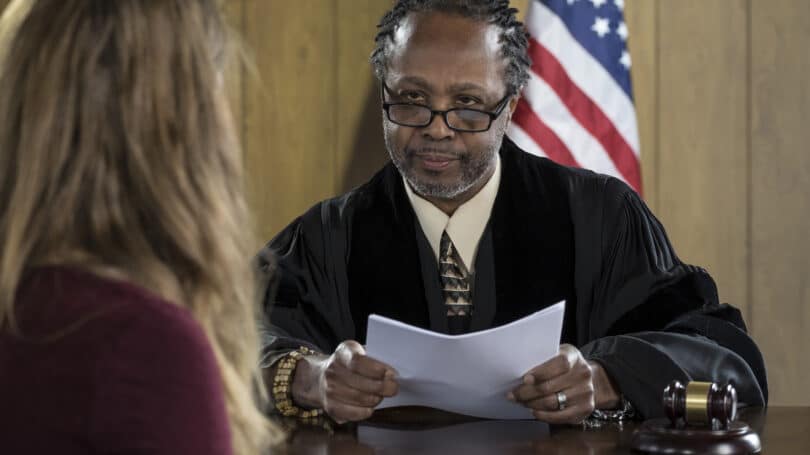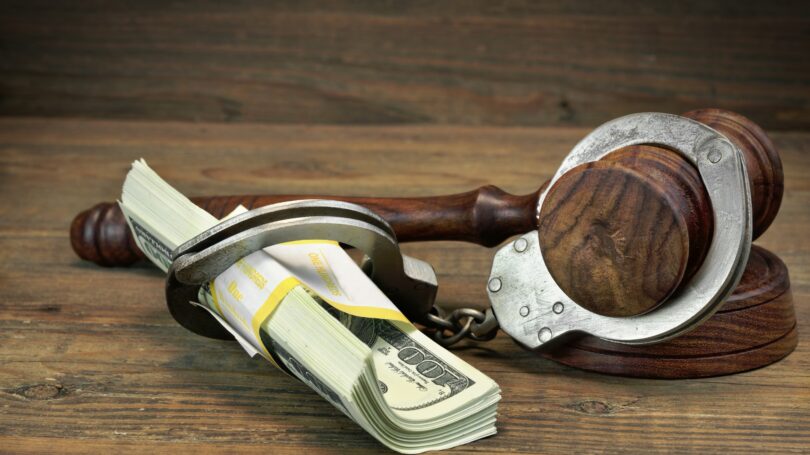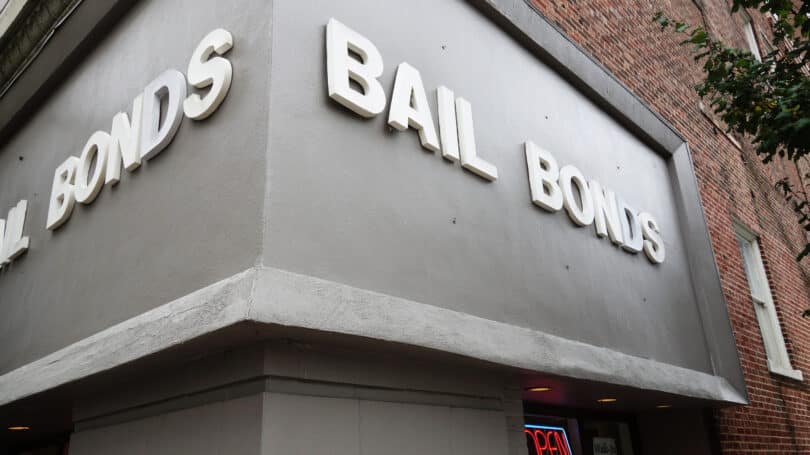Paying bail to get out of jail may seem like a simple concept. The idea is that if someone gets arrested, someone else can pay money and the jailed person goes free. And while that is the essential idea behind bail, there is more that goes into the process.
Often, people who have not gone through the criminal justice system are confronted with a bail situation but are not sure what to do. If you are arrested and have to pay $100,000 in bail, does that mean you will have to stay in jail if you cannot afford to pay the entire amount? Can someone else pay? Can you hire a bondsman to pay for you? How do you go about doing that?
Understanding how bail works, how courts determine bail amounts, what kinds of payment methods you can use, and other similar issues is important for anyone who is faced with arrest, or the arrest of a family member or loved one.
Arrests, Jail, Bail and the Criminal Justice System
Bail is a term that describes the release of a criminal defendant or arrestee after an arrest prior to the end of the criminal case. Bail can – but does not always – involve the defendant (or someone on the defendant’s behalf) paying money to a court. The money ensures that the defendant returns to court for the remainder of the criminal justice process. Therefore, bail is not a punishment given prior to a person being found guilty of any crime, but a way to ensure that criminal defendants return to court without the necessity of keeping them in custody the entire time.
Bail can play an important role in the criminal justice process, as it serves to both limit the amount of jail space needed, and ensure that people who are free while their cases are ongoing will return to court. People can be released on bail at almost any stage in the criminal justice process, such as immediately after an arrest, or even after a court has issued a sentence.
In general, any time someone is arrested there will be three possible outcomes: the arrestee is released, the arrestee is charged and released on bail, or the arrestee is charged and remains in custody until the case comes to an end. Bail is one way people can be released from jail prior to a court determining guilt.
Arrests
When police or law enforcement officers arrest people, they physically take the arrestees into custody. People under arrest are typically taken by police into custody, placed into a police vehicle, and then transferred to a jail or criminal processing facility for an administrative process often referred to as “booking. ” Sometimes the police will release arrestees without filing charges, but if charges are filed, the arrestee will have to remain in custody until released on bail, until a court renders a judgment, or until the case is otherwise resolved.
Booking
Booking is the administrative process that follows an arrest. During this process, the police perform a series of tasks, such as taking the arrestee’s photo, recording personal information such as name, date of birth, and age, taking fingerprints, taking any physical possessions the arrestee has and placing them into a storage facility, searching for any warrants, performing a health evaluation, and placing the arrestee in a detainment holding area.
Post-Arrest Custody, Pretrial Release
After the police have arrested and booked someone, one of three things will typically happen: First, the police can release the defendant with a written notice to appear at court. Second, the police can release the defendant only after he or she pays the appropriate bail amount. Third, the police can keep the defendant in custody until a court holds a bail hearing.
State law determines which of the three options applies in any given situation. In general, arrests for low-level crimes, such as disorderly conduct or petty larceny, will more often result in release with a written notice to appear, while more serious crimes, such as serious violent offenses, will result in the defendant remaining in custody until a court can hold a bail hearing.

Bail Schedules
Bail schedules are lists of bail amount that apply to individual crimes in any jurisdiction. For example, a state’s bail schedule may set bail for the crime of disorderly conduct at $1,000, or set a $5,000 bail for burglary.
States laws will determine not only what bail amounts are appropriate for each crime and whether police can release a defendant without requiring bail, but also whether defendants are allowed to post bail following booking or if they must wait for a bail hearing. They also typically allow judges significant latitude in increasing or decreasing bail when the court deems it appropriate. (Federal courts do not have bail schedules, and bail amounts are up to the discretion of the court.)
For example, the State of California requires a bail hearing in all cases involving specific crimes, such as spousal battery, spousal rape, and making terrorist threats. In general, if state laws allow for it, a defendant can be released on bail immediately after booking as long as the defendant is able to pay the appropriate amount. If the law requires a bail hearing, the defendant will not be able to pay bail or otherwise be released until a court holds the hearing.
Bail Hearings
When a court holds a bail hearing, it determines how much bail applies to a specific case. Courts do not always have to allow bail, and can deny it if allowed by state law.
When the court determines bail amounts or whether to deny bail, it weighs a variety factors:
- Flight Risk. Some defendants pose a higher flight risk than others. For example, defendants who are facing sentences that impose death or long periods of incarceration may be more likely to try to flee than those facing less serious penalties.
- Community Connections. A person with strong connections to a community, such as someone who owns a local business or whose entire family is located in the area, may be less likely to flee or fail to reappear at court than someone who is merely visiting.
- Family Obligations. Courts may be more likely to impose a lesser bail amount when a defendant is responsible for the well-being of family members or other dependents.
- Income and Assets. A defendant with a lot of money or assets may not see a low bail amount as a significant deterrent, while those with few assets may be significantly affected by bail amounts outside of their resources. Similarly, a court can consider if a defendant is employed and likely to lose that employment as a result of being unable to pay bail and remaining in custody.
- Criminal and Court History. People with criminal histories – especially those with histories that involved failures to appear at court – typically have higher bond amounts than those who are in the criminal justice system for the first time. For example, if a defendant has been granted bail numerous times in the past but has always violated bail conditions or failed to appear in court, courts will typically impose much higher bail than they would for someone with no past history of failing to appear. Or, they may even deny bail entirely.
- Seriousness of the Crime. In general, a more serious crime will have a higher bail amount than a less serious crime. For example, bail for someone accused of a minor theft may be $1,000 or less, but bail for someone accused of murder could be hundreds of thousands of dollars or more.
- Public Safety. If a defendant’s release would pose a risk to health and safety of others, or to the community at large, courts typically refuse to allow bail at all. For example, a defendant charged with conspiring to commit an act of terrorism may be denied bail, as releasing that person could pose a risk to the lives of others.
Bail Conditions
In addition to determining a bail amount that a defendant must pay to be released, courts typically impose additional limitations or requirements on defendants when making a bail determination. These limitations are similar to those imposed on people found guilty of a crime and sentenced to probation. Violating bail conditions can result in police taking the defendant back into custody until trial, as well as the forfeiture of any bail paid.
The following are typical conditions of bail:
- Pretrial Check-Ins. Much like checking in with a parole or probation officer, people on bail can have to make regular check-ins with pretrial services officers. Pretrial services officers monitor defendants prior to trial to make sure they are complying with any orders or conditions imposed by the court.
- No-Contact Orders. In cases where the defendant is accused of stalking, domestic violence, making criminal threats, or other similar crimes, the court typically imposes a no-contact order. The order requires the defendant to refrain from contacting the alleged victims of the crime.
- Employment. Courts can require a defendant to maintain employment while on bail. If the defendant is unemployed, the court can require him or her to attempt to find employment while on bail.
- Travel Restrictions. Defendants on bail are typically not allowed to leave the area unless specifically allowed by the court or pretrial services officer.
- Substance Abuse. Bail conditions, especially those in cases involving drunk driving, drug possession, or other substance-abuse related offenses, typically require the defendant to refrain from using drugs and alcohol.
- Firearms Restrictions. Bail conditions may require the defendant to refrain from possessing firearms, even if the charged crimes did not involve the use of firearms.
Post-Conviction or Sentence Bail
In some situations, bail is possible even after a person has been convicted of (or sentenced for) a crime. Typically, once a court issues a jail or prison sentence, the defendant must begin serving the sentence immediately. For example, if a judge sentences someone to five years in prison, bailiffs will take the defendant into custody and transfer him or her to a detention center to begin serving the sentence.
However, courts can allow criminal defendants to be released on bail after a conviction or sentencing if the defendant files an appeal. For example, if a court sentences a defendant to five years in prison but the defendant files an appeal of the conviction, the sentencing court may grant that defendant bail and allow that defendant to remain out of custody until the appeal has been heard by an appellate court.
Like other bail issues, state laws govern post-conviction or post-sentencing bail, and not all states allow for it. In states that do, the court typically has broad discretion in granting bail, as well as in determining the appropriate bail amount to set.
Bail Payment Procedures
Each jurisdiction not only has its own rules on how bail is determined and who can be released, but also has its procedures for how bail payments must be made. Typically, the payment process requires that someone travel to a specific location, such as a courthouse or a jail. A cashier, clerk, or other official at the location is responsible for receiving bail payments. The payer must provide the clerk with specific information, such as the defendant’s name, the case or booking number, and the bail amount to be paid. (The clerk or official often has access to this information, and can find out how much bail must be paid.) The payer must then submit the appropriate bail amount to the clerk.
Once the clerk’s office has received the bail payment, it notifies the corrections officials who are keeping the defendant in custody, and they release the defendant from jail. In some situations, the bail release happens almost immediately because the clerk is located in the same facility as the jail, while in other situations it may take several hours or more for the defendant to be released.
Bail payments must typically be made in cash or with some other form of accepted payment, such as credit or debit card, certified or cashier’s check, traveler’s checks, or money order. Accepted payment amounts differ from jurisdiction to jurisdiction.

Types of Bail
Many people associate bail with a specific cash amount. The general idea is that if you have the money to pay bail after you are arrested, you can get out of jail. But bail is often more complicated than that, especially when the bail amount is large.
In any state or jurisdiction there may be a variety of bail types available. While some types of bail are not available in all states or situations, and some are more or less often employed than others, defendants can expect to encounter one of more of the following types of bail.
1. Cash Bond
In many situations, the police will not release an arrestee with a simple citation, but will release the arrestee after booking if that person pays a cash bond. If the defendant does not have the money, someone else can pay the bail on behalf of the defendant.
The cash bond amount is determined by the state or local bail schedule, or by a court after a bail hearing. As long as the payer has enough money to cover the full bond amount, the defendant is released from police custody.
2. Own Recognizances or Personal Recognizances Bond
Sometimes, a court releases an in-custody defendant on his or her own recognizances or on personal recognizances, also known as an OR or PR bond. OR and PR bonds are similar to a citation and release, only they take place after a court holds a bail hearing. If the court allows this type of bail, the defendant will be released from custody on the condition that he or she reappear in court at a later time and comply with any other bail conditions the court imposes.
3. Unsecured or Signature Bond
An unsecured bond, also known as a signature bond, applies after a court holds a bond hearing and imposes a bail amount, but does not require the defendant to pay that amount to be released. This form of bond is similar both to an OR bond and a release and citation. Instead of paying any cash to be released, the defendant must sign an agreement stating that if she doesn’t appear at court as required, he or she will be required to surrender the bail amount.
4. Secured or Property Bond
A secured bond, or “property bond,” is a type of bail in which the defendant gives the court a security interest in property equal to the worth of the total bail amount. A security interest is a legal right to possess or take a specific piece of property given by the property’s owner to the secured party.
For example, when you buy a car using a car loan, your lender gives you money to buy the car. In return for that money, you give the lender a security interest in the vehicle. You and the lender agree that should you fail to repay the loan in accordance with the terms to which you both agreed, the lender can repossess the car (the collateral) and sell it to recover the money you still owe. The same is true when a bank forecloses on a home when the homeowner fails to pay the mortgage. Both are forms of security interests.
So, with a secured property bond, the defendant or some other bond payer gives a security interest in a specific piece of property to the court as a form of bail. Should the defendant fail to later appear at court, the court can seize the property used as collateral to recover the unpaid bail.
5. Bail Bond or Surety Bond
A bail bond is a form of bail payment provided on a defendant’s behalf by a bail bond agent. Bail bond agents, also known as bondsmen, are people who are in the business of paying bond on behalf of criminal defendants. When defendants use a bail bond agent, they pay the agent a fee and the agent acts as a surety, telling the court that they (the bond agents) will pay the full bond amount should the defendant fail to appear at court.
Bail bond agents make money by collecting a fee from those who want to be bailed out. Typically, that fee is 10% to 15% of the amount of bail. So, if a court sets a defendant’s bail at $10,000, that defendant (or someone acting on the defendant’s behalf) can pay a bail bond agent $1,000 and the bond agent will act as a surety on the defendant’s behalf.
Like secured or property bonds, bail bond agents typically require the defendant or the paying party to provide collateral or some other form of security against the bond. (They also require that the defendant sign a contract stating the terms of the agreement.) For example, a bond agent may require the defendant to physically give the bond agent pieces of jewelry that the bond agent can sell to recover the full bond amount if the defendant fails to appear in court. Similarly, the bond agent might require the defendant, or someone else, to sign a security interest in a car, home, or other piece of property that the bond agent can repossess if the defendant fails to appear.

Getting Bail Money Back From the Court
Because bail is not a form of punishment or a criminal sentence, someone who pays bail is entitled to have that money returned if the defendant complies with all bail terms and conditions. Generally, there are two possible outcomes when someone pays bail: the bail is released back to the payer, or the bail is forfeited.
Bail Release or Refund
If a criminal defendant is released from custody on bail, the bail will be repaid to the payer upon the conclusion of the case. This release or repayment of bail depends upon both the kind of bail used and the jurisdiction in which the bail is paid.
For example, someone paying cash bail in Suffolk County, New York, typically has his or her bail payment released within two to six weeks from the conclusion of the case. On the other hand, should the defendant use a property bond, the court releases the lien on the property. The lien release, like the release of the bail payment, typically takes several weeks or more to conclude.
In other jurisdictions, such as federal courts, the court does not automatically release bail upon conclusion of the criminal case. In such jurisdictions, the bail payer must file a document (called a “petition”) with the court, asking it to release the money paid; or, in the case of a property or secured bond, to release the lien placed on the property used as collateral.
Even if bail is released, it is common for the court to keep a small amount of it as an administrative or similar type fee. For example, in Massachusetts, the court keeps $40 of any bail money paid.
Bail Forfeiture
In situations where a defendant is released from custody on bail but later fails to appear in court as required – or otherwise fails to comply with any of the conditions the court imposed when granting bail – the bail amount is forfeited.
For example, if you are arrested and pay $1,000 in cash as bail, you will lose that $1,000 if you miss your court date. Similarly, if someone pays bail on your behalf, the payer forfeits should you miss court.
If a property bond is involved and the defendant fails to appear, the court can repossess or foreclose on the secured property. For example, if your father uses his home as the collateral in a secured property bond and you fail to appear, the court can foreclose on the home and sell it at auction to recover the bail amount.
Bail Violation and Failure to Appear Petitions
If a defendant fails to appeal in court and forfeits bail, there is still a chance the court will reinstate bail (allowing the defendant to remain out of custody until the case concludes) and return the bail that has already been paid. A defendant can petition a court to reinstate bail (or to not forfeit bail) if the defendant can show that there were good reasons – such as experiencing a medical emergency – why he or she missed court.
Getting Bail Money Back From the Bail Bond Agent
When a defendant uses a bail bond agent to post bail, the defendant must pay the bondsman’s fee, and may also have to hand over collateral or sign a security agreement. Should the defendant comply with bond conditions, the bond agent will return the collateral or release the lien created by the security agreement upon the conclusion of the case. However, the bond agent’s fee (the 10% to 15% of the total bail amount) is not returned no matter the outcome.
Bond Forfeiture and Bounty Hunters
Should a defendant who used a bond agent’s services fail to appear in court or otherwise violate bail terms, the agent can usually try to find the defendant, take that person into custody, and physically take the defendant back to police custody. Courts typically grant bond agents a grace period after a defendant violates bail terms. If the agent can return the defendant to court within that grace period, the court usually will not require the agent to pay the full bail amount.
As part of this process the bail bond agent can employ bounty hunters, also called bail enforcement agents, to track down and apprehend the defendant. Bounty hunters, like bail bond agents, are not government employees or law enforcement officers. They do not have general arrest powers, but can arrest a defendant who used the bail bond agent’s services. This is because as part of the contract defendants sign with the bail bond agent, defendants typically agree to allow the bond agent, or bounty hunters working for the agent, to enter their home, arrest them, or take other actions that would typically be illegal without the defendant’s consent.
Note that state laws on both bail agents and bounty hunters can differ significantly, and not all states allow for bail bond agents or bounty hunters.

Final Word
Like all parts of the criminal justice system, bail can be much more complicated than many people imagine it to be. Bail can involve a lot of money and serious financial risks, even in the best of circumstances – and that isn’t even taking into consideration the potential consequences that come with a criminal case. Like all matters concerning criminal law, knowing what your options are and making sure you are adequately protected often requires that you speak to a lawyer before you make any decisions. Receiving legal advice from a qualified expert is always preferable to making a decision without having all the facts.
Have you ever had to pay bail or bail someone out of jail?